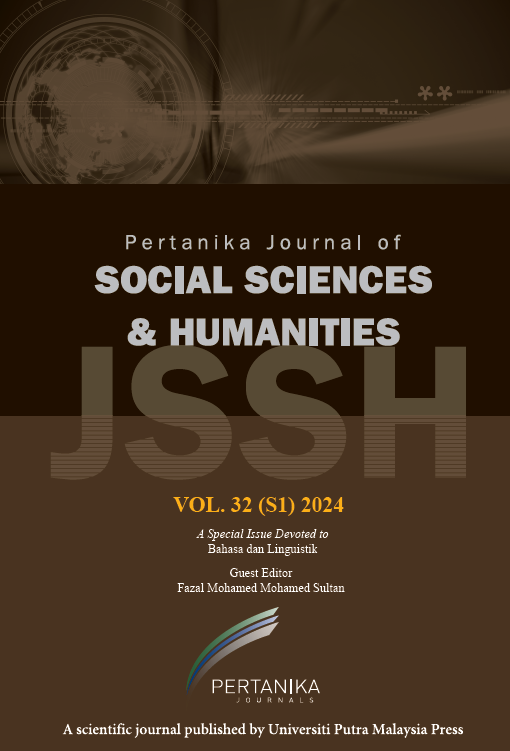PERTANIKA JOURNAL OF SOCIAL SCIENCES AND HUMANITIES
e-ISSN 2231-8534
ISSN 0128-7702
J
J
Pertanika Journal of Social Science and Humanities, Volume J, Issue J, January J
Keywords: J
Published on: J
J
-
Anderson, L., Krathwohl, D. R., Airasian, P. W., Cruikshank, K. A., Richard, M., Pintrich, P. R., Raths, J. D., & Wittrock, M. C. (2001). A taxonomy for Learning, Teaching and Assessing: A Revision of Bloom’s Taxonomy of Educational Objectives. Longman.
-
Bloom, B. S., Engelhart, M. D., Furst, E. J., Hill, W. H., & Krathwohl, D. R (1956). Taxonomy of Educational Objectives; The Classification of Education Goals - Handbook 1 Cognitive Domain. Longmans.
-
Carpenter-Horning, A. K. (2018). The Effects of Perceived Learning on Open-Sourced Classrooms within the Community Colleges in the South-Eastern Region of the United States. Liberty University.
-
Chan, C., & Fok, W. (2009). Evaluating learning experiences in virtual laboratory training through student perceptions: A case study in electrical and electronic engineering at the University of Hong Kong. Journal of the Higher Education Academy, 4(2), 70-75. https://doi.org/10.11120/ened.2009.04020070
-
Chowdury, H., Alam, F., & Mustary, I. (2019). Development of an innovative technique for teaching and learning of laboratory experiments for engineering courses. Energy Procedia, 160, 806-811. https://doi.org/10.1016/j.egypro.2019.02.154
-
Davies, C. (2008). Laboratory and Practical Work in the Engineering Curriculum: Learning and Teaching in Laboratories. The Higher Educational Academy Engineering.
-
Elif, I. (2018). An overview of problem solving studies in physics education. Journal of Education and Learning, 7(4), 191-200. https://doi.org/10.5539/jel.v7n4p191
-
Gamage, K. A. A., Wijesuriya, D. I., Ekanayake, S. Y., Rennie, A. E. W., Lambert, C. G., & Gunawardhana, N. (2020). Online delivery of teaching and laboratory practices: Continuity of university programmes during COVID-19 pandemic. Education. Sciences, 10(10), Article 291. https://doi.org/10.3390/educsci10100291
-
Jolliffe, I. (2014). Principal component analysis. In N. Balakrishnan, T. Colton, B. Everitt, W. Piegorsch, F. Ruggeri, L. Jozef & Teugels (Eds.), Wiley StatsRef: Statistics Reference Online (pp. 2-29). John Wiley & Sons. https://doi.org/10.1002/0470013192.bsa501
-
Kapilan, N., Vidhya, P., & Gao, X. Z. (2021). Virtual laboratory: A boon to the mechanical engineering education during COVID-19 pandemic. Higher Education for the Future, 8(1), 31-46. https://doi.org/10.1177/2347631120970757
-
Kawasaki, H., Yamasaki, S., Masuoka, Y., Iwasa, M., Fukita, S., & Matsuyama, R. (2021) Remote teaching due to COVID-19: An exploration of its effectiveness and issues. International Journal of Environmental Research and Public Health, 18(5), Article 2672. https://doi.org/10.3390/ijerph18052672
-
Kearney, P. (1994). Affective learning scale. In R. B. Rubin, P. Palmgreen, & H. E. Sypher (Eds.), Communication Research Measures: A Sourcebook (pp. 81-85 & pp. 238-241). The Guilford Press.
-
Krathwohl, D. R., Bloom, B. S., & Masia, B. B. (1964). Taxonomy of Educational Objectives: The Classification of Educational Goals - Handbook II: Affective Domain. David McKay.
-
Laerd Statistics. (2018). Principal component analysis (PCA) using SPSS statistics. Laerd Statistics. https://statistics.laerd.com/spss-tutorials/principal-components-analysis-pca-using-spss-statistics.php/Accessed
-
Lewis, L. D. (2014). The Pedagogical Benefits and Pitfalls of Virtual Tools for Teaching and Learning Laboratory Practices in the Biological Sciences. https://www.advance-he.ac.uk/knowledge-hub/pedagogical-benefits-and-pitfalls-virtual-tools-teaching-and-learning-laboratory
-
MacLeod, J., Yang, H. H., Zhu, S., & Li, Y. (2018). Understanding students’ preferences toward the smart classroom learning environment: Development and validation of an instrument. Computers & Education, 122, 80-91. https://doi.org/10.1016/j.compedu.2018.03.015
-
Martin, F., Stamper, B., & Flowers, C. (2020). Examining student perception of readiness for online learning: Importance and confidence. Online Learning Journal, 24(2), 38-58.
-
Murphy, M. P. (2020). COVID-19 and emergency e-learning: Consequences of the securitisation of higher education for post-pandemic pedagogy. Contemporary Security Policy, 41(3), 492–505. https://doi.org/10.1080/13523260.2020.1761749
-
Nature News. (2020, April 22). Corononavirus: The first three months as it happened. Nature News. https://www.nature.com/articles/d41586-020-00154-w
-
Rachmawati, E., Mufidah, L., Sulistiyani, T., & Ab-Latif, Z. (2019). Examining the students’ cognitive, affective and psychomotor abilities in the bakery industry. Journal of Technology and Operations Management, 14(2), 1-9. https://doi.org/10.32890/jtom2019.14.2.1
-
Rovai, A. P., Wighting, M. J., Baker, J. D., & Grooms, L. D. (2009). Development of an instrument to measure perceived cognitive, affective, and psychomotor learning in traditional and virtual classroom higher education settings. Internet and Higher Education, 12(1), 7-13. https://doi.org/10.1016/j.iheduc.2008.10.002
-
Simpson, E. J. (1974). The classification of educational objectives in the psychomotor domain. In R. J. Kibler, D. J. CegalaL, L. Barker & D. T. Miles (Eds.), Objectives for Instruction and Evaluation (pp. 107-112). Allyn and Bacon.
-
Tan, P. L. (2021, June 1). Online learning: Leave no student behind. The Star. https://www.thestar.com.my/opinion/letters/2021/06/01/online-learning-leave-no-student-behind
-
Triyanti, Murtono, & Sri, U. (2021). Problem-based technology and science development to improve science learning outcomes in elementary schools. ANP Journal of Social Science and Humanities, 2(2), 151-156. https://doi.org/10.53797/anp.jssh.v2i2.21.2021
-
Waltner, E. M., Rieß, W., & Mischo, C. (2019). Development and validation of an instrument for measuring student sustainability competencies. Sustainability, 11(6), Article 1717. https://doi.org/10.3390/su11061717
-
Zhai, G., Wang, Y., & Liu, L. (2012). Design of electrical online laboratory and e-learning. IERI Procedia, 2, 325-330. https://doi.org/10.1016/j.ieri.2012.06.096
ISSN 0128-7702
e-ISSN 2231-8534
Recent Articles




